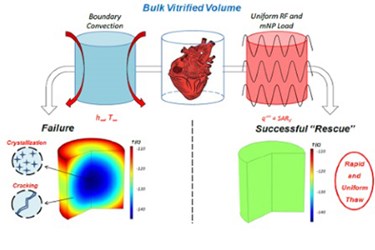RF-Heated Magnetic Nanoparticles Could Improve Organ Cryopreservation
By Chuck Seegert, Ph.D.

Cryopreserving organs and masses of tissue has improved significantly, but the thawing of these organs has not. Now an approach using radio frequency (RF) and magnetic nanoparticles (mNPs) may allow uniform thawing that avoids the damage seen with heating before.
Organ transplants are often limited by time. When a donor becomes available, the tissues must be harvested rapidly and then delivered to a recipient within a relatively short timeframe to prevent damage to the organ. Because of these limitations, only a certain distance can be travelled before implantation must occur — a problem that would be solved if tissues could be cryopreserved.
Efforts to cryopreserve tissues and organs have made significant advances, but those tissues and organs must also be thawed, a separate process that is subject to limitations with current technology. An international research team led by the University of Minnesota may now have made a significant step forward in this area by using RF-heated MNPs, according to a recent press release from World Scientific.
"Avoiding ice formation and the associated tissue injury during cryopreservation of bulky biomaterials has led to a focus on vitrification (vitreous "ice-free" cryopreservation) in recent times,” said Michael Taylor, Ph.D., an expert cryobiologist, Adjunct Professor at Carnegie Mellon, and VP of Cell and Tissue Systems, in the press release. “While this approach has been successfully applied to small cell aggregates and thin tissues, extrapolation to larger bulk tissues of a clinically relevant size has thus far failed ... Progress in developing appropriate cooling technologies to achieve vitrification has advanced more rapidly than complimentary warming techniques, which now present the principal stumbling block.”
When dispersed into the bulk of the tissue, mNPs are capable of evenly distributing heat throughout the tissue, according a study published by the team in Technology. Using radiofrequency to vibrate the particles, heat is distributed throughout the specimen, avoiding heat transfer that comes from the outside to the inside, as seen in more common “boundary” heating processes. Using this method, heating can be conducted at very high rates (hundreds of Celsius per minute), which helps avoid the problems seen historically.
In addition to the thawing advances, the team has developed a micro-computed tomography approach to be used in quality control activities, according to the study. The difference in density between thawed and frozen tissue can be detected with micro-CT, allowing a thorough understanding of the cryopreserved status of the tissue.
While transplantation of organs is an essential and life-preserving technology, the hope of generating complete artificial organs is a major driving force in the tissue engineering space. Recently an article published on Med Device Online discussed a regenerated thymus that was cultured and then implanted into a mouse to create a completely functional replacement organ.
Image Credit: World Scientific
